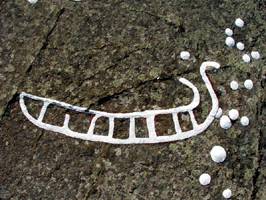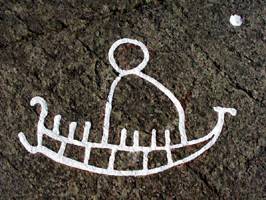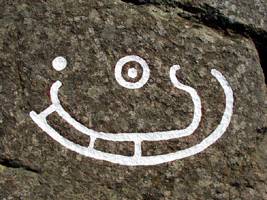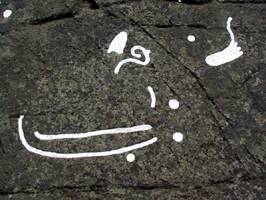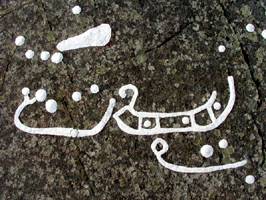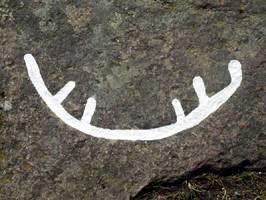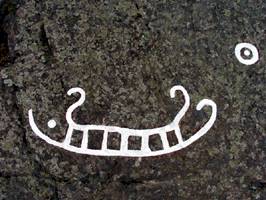Back to Don's Maps
Bornholm rock engravings
A striking feature of the Bornholm rock engravings is their recurring themes of ships. In prehistoric Bronze Age Scandinavia it was much easier to travel by sea than by land. Bornholm was not isolated by the sea, it was connected to the rest of the region by the sea.
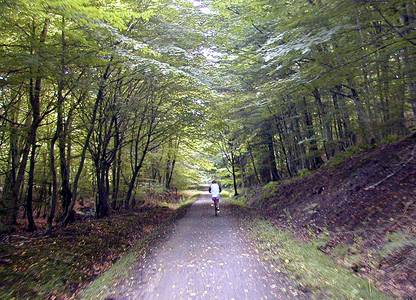

These abstract images are of ships.
Archaeologists have never found a Bronze Age ship. The Hjortespring ship from Als in the southern part of Jutland is the closest thing to a Bronze Age ship found so far, but actually the Hjortespring ship is from the Iron Age, 400 years B.C. It was originally built in the southern Baltic Sea region and it is not unlikely that it visited Bornholm.
When prehistoric man created pictures it is believed that it was almost always with a mythical or religious focus. Taken out of context, the rock carvings say little about the life of the people, but when placed in the context of other finds, one can gain an impression of the myths and rituals of the Bronze Age.
Many of the illustrations suggest that the ship was the means of transportation of the sun. In addition, the sun was aided by the horse and other animals. Perhaps the ship also helped the dead in their journey to the next world.
On Bornholm there are ship-shaped graves from the Bronze Age. The people of the Bronze Age lived in a world where the mythical and the real were closely connected. A real and perilous voyage across the sea might have had a mythical content. Rituals were necessary to maintain world order. Most likely, as elsewhere in the world, rituals were linked to the seasons and to the turning points of life.
Photo and text adapted from: http://www.rane-online.org/

As well as ships, the wheel is a recurring theme in the images at this site. It is often decorated with cups or round depressions, as well as being divided into four sectors, as is the case in this engraving.
Photo: http://www.bornholmsmuseer.dk
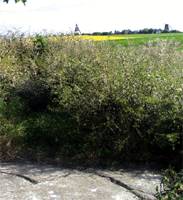
The engravings are cut into relatively flat granite slabs. They would originally have stood out as white engravings against the grey rock, but have gradually faded to the same colour as the background rock surface.
In order to see them, they must be either be viewed at night by artificial light at a low angle of incidence to the plane of the rock, or else the engravings must be emphasised by colouring with paint, as is done here. Elsewhere the paint used is red to mimic red ochre, but here it is white.
These rock slabs occur randomly across the island, and at this location are almost obscured by the vegetation which comes right up to the edge of the granite slabs.
Photo: http://www.rane-online.org/
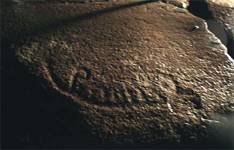
This image of a ship was carved into a stone so deeply that it may still be seen easily. Many of the carvings are now very faint, and difficult to see.
Bronze Age Southern Scandinavia was a homogeneous cultural region in the Bronze Age. Man supported himself through agriculture and livestock and a large part of the landscape was open range land. It was a tribal community with significant social differences.
Part of the religious practice of this time and in this place meant costly equipment and sacrifices, which could only be supplied by powerful families. These families have been responsible for contact with southern European cultures. Bronze was an article imported from the middle parts of Europe. In fact, the mythology we come across in the rock carvings seems to be influenced by the Mediterranean region. Voyages of these lengths at this time are an exception to the rule. Normally, ideas spread like circles in water.
Photo and text adapted from: http://www.rane-online.org/
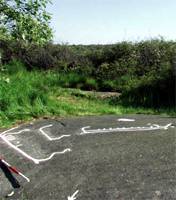
These engravings of ships are large, and have been made visible by white paint.
Photo: http://www.rane-online.org/
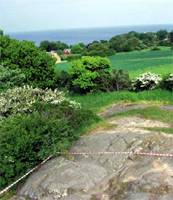
The rock surfaces are open to the skies, and over the centuries have succumbed to the effects of weather. Here they are very difficult to see, but the photograph helps to show how the rock surfaces are a part of a living landscape, with farms and houses all around.
Photo: http://www.rane-online.org/
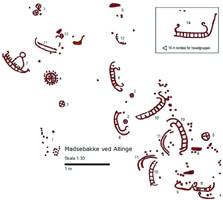
Researchers have spent a great deal of time and effort to study the rock engravings, and here they are shown as graphic images rather than as actual images pecked into the stone.
These are images from Madsebakke, just a bit north of Allinge on the northern tip of Bornholm. It is one of the largest collections of rock engravings in Denmark.
The carvings are situated on a sloping ridge or hill, overlooking the sea. An actual photograph of these images may be seen below.
Photo: http://www.rane-online.org/
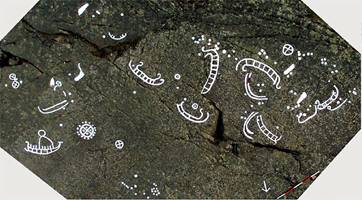
This is an image which is from the Bornholm Museum site, which has been carefully photographed under the best possible conditions. Each of the images here was then photographed individually.
Not all of these individual photographs are available at the Bornholm Museum site, (the dreaded 404 error is to blame) but the ones which are accessible are shown below.
Photo: http://www.bornholmsmuseer.dk
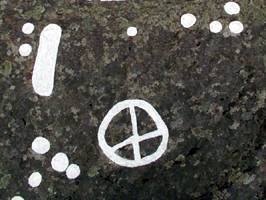

These are individual images from the large stone platform above.
Photo: http://www.bornholmsmuseer.dk
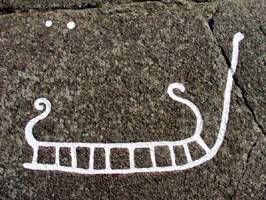
This image is 15 metres to the north east from the rock surface above.
Photo: http://www.bornholmsmuseer.dk
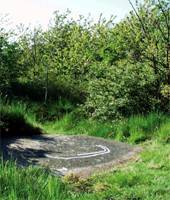
Clearly, some of the engravings are enigmatic, since time and weather have removed the finer features of many of them.
This rock surface is enclosed in a glade. It is very similar to the image shown as number 11 in the diagram of the Madsebakke carvings in the image above.
Near Madsebakke, just a bit north of Allinge on the northern tip of Bornholm, is Denmark’s largest rock carving area. The carvings are from the latter part of the Bronze Age or more than 2500 years ago. They have probably not all been made at the same time.
It is more likely that a 400 year period lies between the oldest and the youngest illustrations. Excavations at the base of the rocks reveal that the activities on the site were not limited to rock carvings. Hollows containing stone made brittle by fire and traces of a stone pavement have been found near the rock.
Archaeologists believe that Madsebakke was a sacred place for the people in the area. In fact, the area might have had significance for a much larger area. The rock carvings have most likely been made as a part of a more extensive ritual. One can only guess what these rituals have been, but they might have been offerings, sacred meals, music and dance.
There used to be two additional rock faces with rock carvings just 100 metres from Madsebakke. Unfortunately, these rocks were blown up in 1885 when granite pieces were produced in many granite quarries in the northern part of Bornholm. It is very likely that the same thing would have happened at Madsebakke, were it not for the poor quality of the rock.
One of the most energetic amateur archaeologists on Bornholm at that time was a school teacher, L. Petersen from Allinge. He managed to make a sketch of the carvings on both rock surfaces before their destruction. His sketches show ships of the common type but also the only clear figure of a man found on Bornholm. Combined, these three rocks make up Bornholm’s most distinctive compilation of rock carvings. Many other rock carvings may be found within a radius of one to two km.
Photo and text adapted from: http://www.rane-online.org/

This is one of the first recordings of the images at Bornholm, drawn by L. Petersen from Allinge.
This sketch is very important, for it shows one of the very few images of a human from the area.
To me, the figure appears to have its head cast back, with a large tongue showing, and the arms as simple sticks above the relatively well shown legs of the figure. The rod engraved above the figure may or may not have been completed at the same time, and may be quite unrelated - Don
Photo: http://www.rane-online.org/
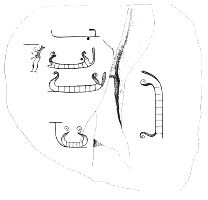

These are some of the drawings made by L. Petersen, possibly about 1885.
Photo: http://www.bornholmsmuseer.dk
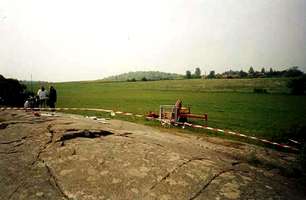
This is the major rock carving locality in Bornholm with a total number of more than 20 figures. On a small panel, separated from the main carving, is a simple rock carving of a ship with extended prows turned upwards, and with the keel-line extended and turned upwards. There are no crew-lines (?) but the area between the gunwale and keel are separated by a number of strokes.
There are 8 cup marks over the ship. About 7 m SW is the main panel at Madsebakke. There are a number of ship figures, of which some have short crew-lines (?). One ship has a small animal in the stem, probably a horse from whose neck a line is attached to a circle figure above the centre of the ship. (? I have been unable to identify this image - Don) Between two of the ship figures is a wheel cross, 28 cm diameter surrounded by cup marks and with four cup marks between the spokes.
The photo above depicts the Madsebakke locality during documentation and registration in June 2001 showing the surrounding fields in the background (photo Li Winter 2001).
Photo and text adapted from: http://www.europreart.net
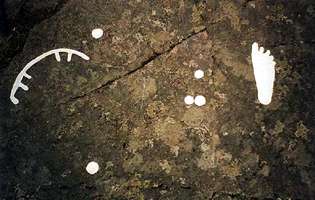
There are another 3 weathered ship figures, of which one has a high prow with an animal-head decoration, another prow ends with a loop. Many of the ships are double-lined with vertical frame-strokes in the hull. There are a number of cup marks distributed over the panel, some clearly connected with the carved figures.
There are also ship figures which are single-lined, with a twist or loop at the end of the extended prow. Three foot prints are totally carved out, and there are a number of fragmentary prints at the top of the panel. Along the E side of the panel there are a larger number of cup marks, and another group are found at the SW part of the rock, towards the top.
There are in total 10 ship figures, 7 foot prints, 1 wheel cross, 2 curved lines, and a large number of cup marks.
The photo above shows a detail of Madsebakke - 5 cup marks, 1 ship and 1 totally carved out foot print (photo Li Winter 2001).
Photo and text adapted from: http://www.europreart.net


Damage to the environment including weathering of the rock surface have been ongoing. The cause is to be found in the changes of environment created by man and environmental pollution. Essential accelerating elements of weathering are acid rain, humic acid created in scientifically managed forests, and changes of the flora, lichen and moss.
The photos here show rock carving figures at Madsebakke during documentation and registration in June 2001 (Photo Li Winter 2001)
Photo and text adapted from: http://www.europreart.net
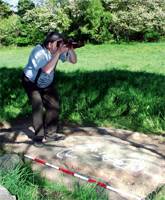
Here a camera is being used to record the images. The camera is specially adapted for the task, allowing the photographer to take a photograph from directly above the engraving while viewing the image about to be captured.
The photographer's t-shirt has Bornholm images on it too!
Photo: http://www.rane-online.org/
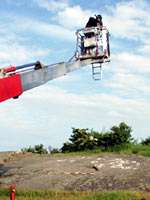
Other methods used when archival photographs are needed include the use of a crane, as shown here.
Photo: http://www.bornholmsmuseer.dk
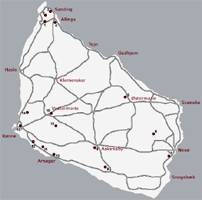
Map of the island of Bornholm.
Photo: http://www.rane-online.org/
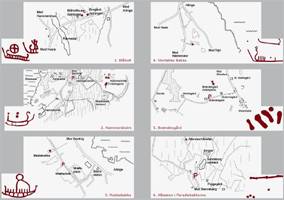
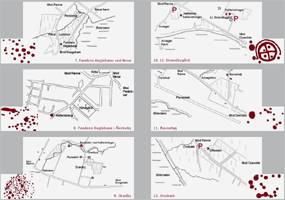
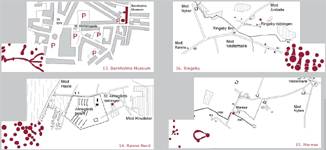
The sites are spread right across the island.
The numbers refer to those on the map of the whole island above.
Photo: http://www.rane-online.org/

This engraving of a foot shows individual toes.
Photo: http://www.rane-online.org/
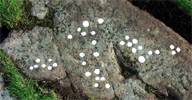
The cups ground into the rock surface are found elsewhere in the world, in places like Australia, but here there is no clue as to their meaning.
Rock carvings can be found all over Bornholm and not just near the tourist sites. Anywhere the people of the Bronze Age have been living or cultivating the earth on Bornholm, there are rocks and stones with cup shaped marks.
The marks are round indentations, typically 4-5 cm wide and 1-10 mm deep. Hundreds of cup marks might be found in one place. Sometimes they form rows or patterns but mostly they are just a few randomly scattered marks. The cup marks are a mystery. Their significance is unknown but may be associated with fertility rituals.
Perhaps the marks have been made as a part of the farming of the land or to better the life of man and beast. The physical act of indenting the rocks with these marks might have had a magical value in its own right.
Photo and text adapted from: http://www.rane-online.org/
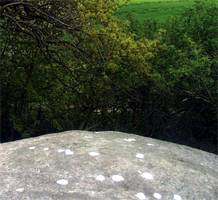
These cups are on a rock slab high above the road seen through the trees.
Photo: http://www.rane-online.org/
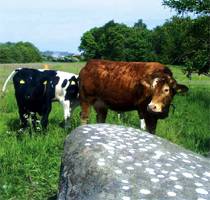
The rocks are mostly protected from casual damage from animals by either their elevated position or by being surrounded by high vegetation.
Perhaps it is just that those which were not thus protected have already disappeared!
Photo: http://www.rane-online.org/
